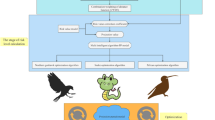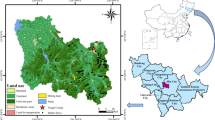Abstract
The debris flow hazards endanger the life and property safety of the people, so the investigation about the risk level assessment of debris flow has great significance to prevent its occurrence. Due to the randomness of debris flow hazards, the projection pursuit classification (PPC) model with the acceleration genetic algorithm is introduced to assess the risk level of debris flow hazards in Zhouqu, China. At first, the index systems of debris flow hazards are established, and the principle of projection pursuit classification model is narrated. Then the risk assessments of 10 different gullies in Zhouqu are performed based on PPC model, the results demonstrate that the most risk levels of debris flow of 10 gullies in Zhouqu are high or higher risk, the results assessed by using the PPC model are basically consistent with the results of actual investigation, except that Anmenxia gully, its accurate rate arrives at 90%, so conclusions are drawn that it is feasible to estimate the risk level of debris flow by using the PPC model, a new method and thoughts can be provided to assess the risk level of debris flow in future.







Similar content being viewed by others
References
Bhuwani P, Mamadou F, Bahram D (2020) GIS-based assessment of debris flow hazards in Kulekhani Watershed, Nepal. Nat Hazards 101:143
Cao LL, Xu LR, Chen SY (2014) Assessment of debris flow hazard based on fuzzy network. Hydrogeol Eng Geol 42:2
Chen JW, Zhou XP (2019) The enhanced extended finite element method for the propagation of complex branched cracks[J]. Eng Anal Boundary Elem 35(104):46–62
Chen J, Zhou X, Zhou L, Berto F (2019) Simple and effective approach to modeling crack propagation in the framework of extended finite element method[J]. Theoret Appl Fract Mech 106:2
Chen Z, Yang P, Liu H, Zhang W (2019) Characteristics analysis of granular landslide using shaking table model test[J]. Soil Dyn Earthq Eng 1(126):105761
Chen L, Zhang W, Gao X, Wang L, Perego U (2020) Design charts for reliability assessment of rock bedding slopes stability against bi-planar sliding: SRLEM and BPNN approaches[J]. Georisk 12(9):10211
Chiu CL (1987) Entropy and probability concepts in hydraulics. J Hydraul Eng 113(5):583–599
David JV (1984) Landslide Hazard Zonation: A Review of Principles and Practice [M]. Fr. Paris U.N Educ Sci Cult Org 2:1–63
Fu XY, Li JS, Yu JY (2018) The grey relational analysis of external factors on rutting formation[J]. Transp Sci Technol 28(1):87–90
Gao X, Liu H, Zhang W, Wang (2018) Influences of reservoir water level drawdown on slope stability and reliability analysis. Georisk Assess Manag Risk Eng Syst Geohaz 13(2):1-9
Gu XB (2021) The risk assessment of debris flow hazards in Banshanmen Gully based on the entropy weight-normal cloud method. Adv Civ Eng 1:1–11
Gu XB, Wu QH (2016) The application of nonordinary, state-based peridynamic theory on the damage process of the rock-like materials. Math Probl Eng 3(8):1–9
Hou J, Du Y (2020) Spatial simulation of rainstorm waterlogging based on a water accumulation diffusion algorithm. Geomat Nat Haz Risk 11(1):71–87
Jia JX, Wang XY, Hersi NAM (2019) Flood-risk zoning based on analytic hierarchy process and fuzzy variable set theory. Nat Hazard Rev 20:3
Liu XL (1996) Assessment on the severity of debris flows in mountainous creeks of southwest China, Proceedings of International Symposium of Interpravent 1996 — Garmisch-Partenkirchen, Tagungspublikation, Band 4, pp 145–154
Liu XL, Zhang SL (1993) Evaluation of the risk degree of debris flow in ravine[J]. J Soil Water Conserv 7(2):20–25
Niu QF (2017) Susceptibility assessment of disaster environment for landslide hazard based on GIS in Lanzhou Area. J Catastrophology 32:3
Tan BY (1986) Quantified comprehensive evaluation for the scope and intensity of muo-rock flow gully activity [J]. J Railw Sci 3(8):74–82
Ware JE, Kosinski M, Keller SD (1996) A 12-item shortform health survey. Med Care 34(3):220–233
Wu W (2017) Debris flow risk assessment based on grey correlation analysis method a case study of Yinpohe debris flow in Lushui County. Geol Disasters Environ Prot 3:21
Xue Y, Liu Y, Dang F (2019) Assessment of the nonlinear flow characteristic of water inrush based on the brinkman and forchheimer seepage model. Water 11:4
Yang XL, Zhang S (2018) Risk assessment model of tunnel water inrush based on improved attribute mathematical theory. J Cent South Univ 25:2
Zhang M (2020) Hazard assessment of debris flow along highway of high altitude cold and intensity regions with aid of ArcGIS. Chin J Geol Hazard Control 31:2
Zhou XP, Gu XB (2016) Seismic bearing capacity of shallow foundations resting on rock masses subjected to seismic loads. KSCE J Civ Eng 20(1):216–228
Zhou X, Wen H, Zhang Y, Xu J, Zhang W (2021) Landslide susceptibility mapping using hybrid random forest with geodetector and RFE for factor optimization[J]. Geosci Front 12(5):101211
Acknowledgements
This work is supported by the first batch of Natural Science Foundation of SiChuan Provincial Department of Education (No. 17ZA0270). The cross project in Nanyang Institute of Technology (230067). The National natural foundation in china (41672357). The start-up foundation (510126). Sichuan Science and Technology Program (No: 2020YJ0424).
Author information
Authors and Affiliations
Corresponding author
Ethics declarations
Conflict of interest
The authors declare that they have no conflict of interest.
Additional information
Publisher's Note
Springer Nature remains neutral with regard to jurisdictional claims in published maps and institutional affiliations.
Rights and permissions
About this article
Cite this article
Gu, X.B., Shao, J.L., Wu, S.T. et al. The Risk Assessment of Debris Flow Hazards in Zhouqu Based on the Projection Pursuit Classification Model. Geotech Geol Eng 40, 1267–1279 (2022). https://doi.org/10.1007/s10706-021-01961-2
Received:
Accepted:
Published:
Issue Date:
DOI: https://doi.org/10.1007/s10706-021-01961-2




